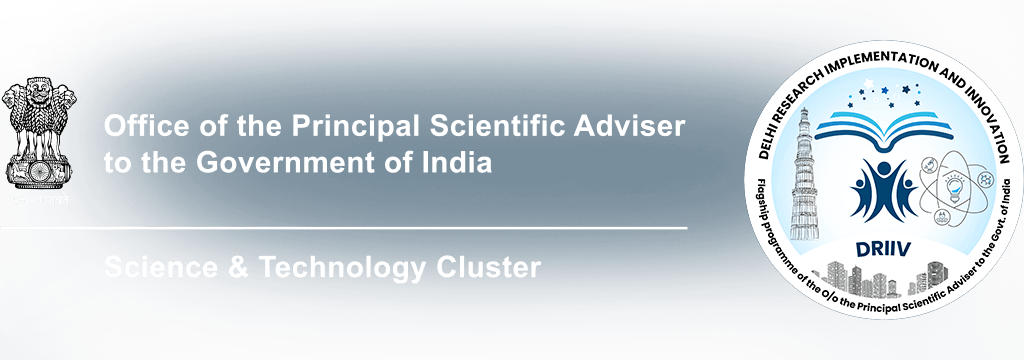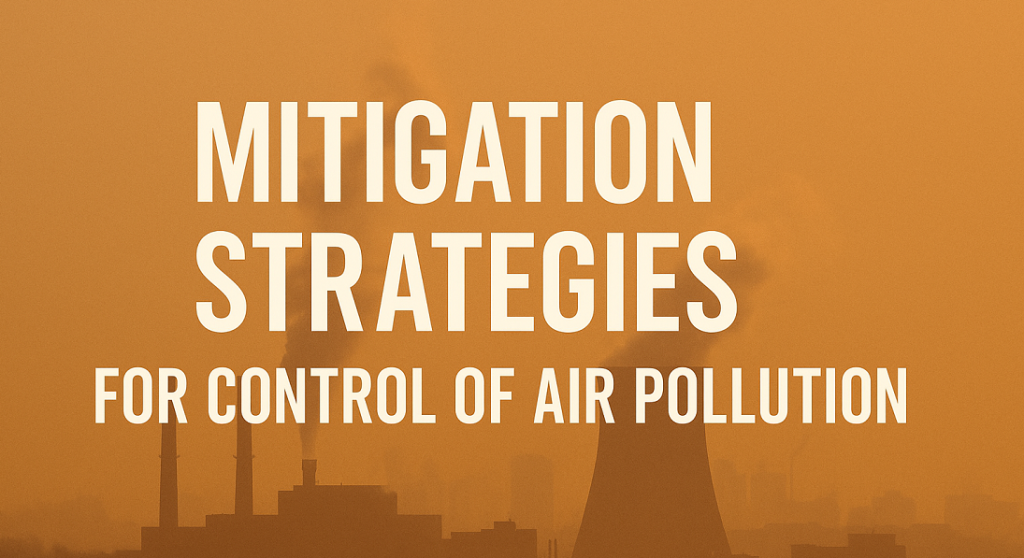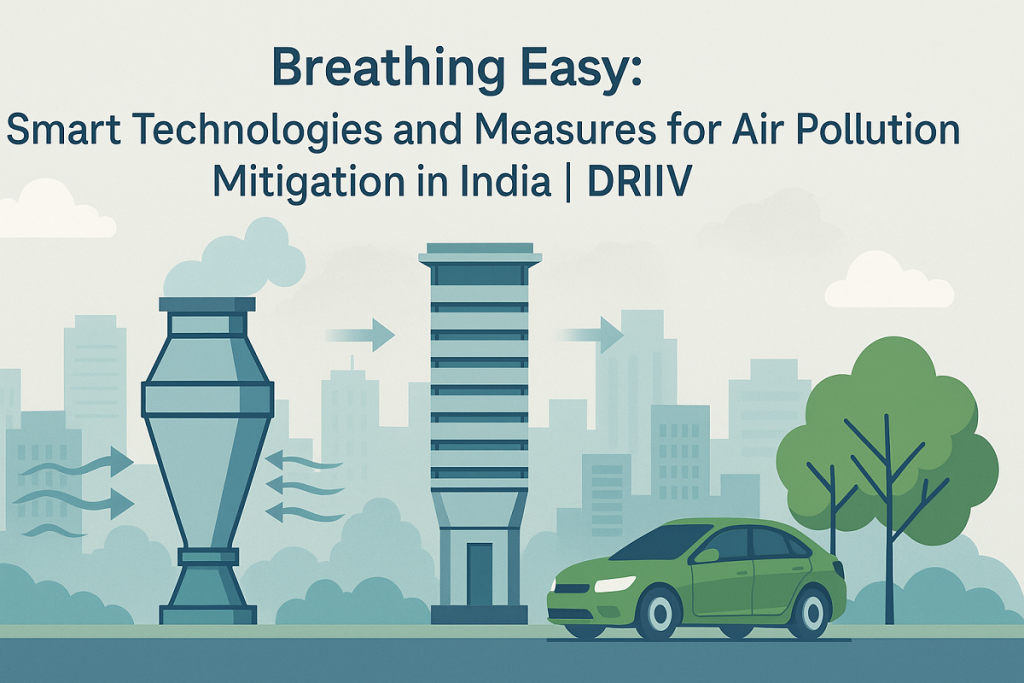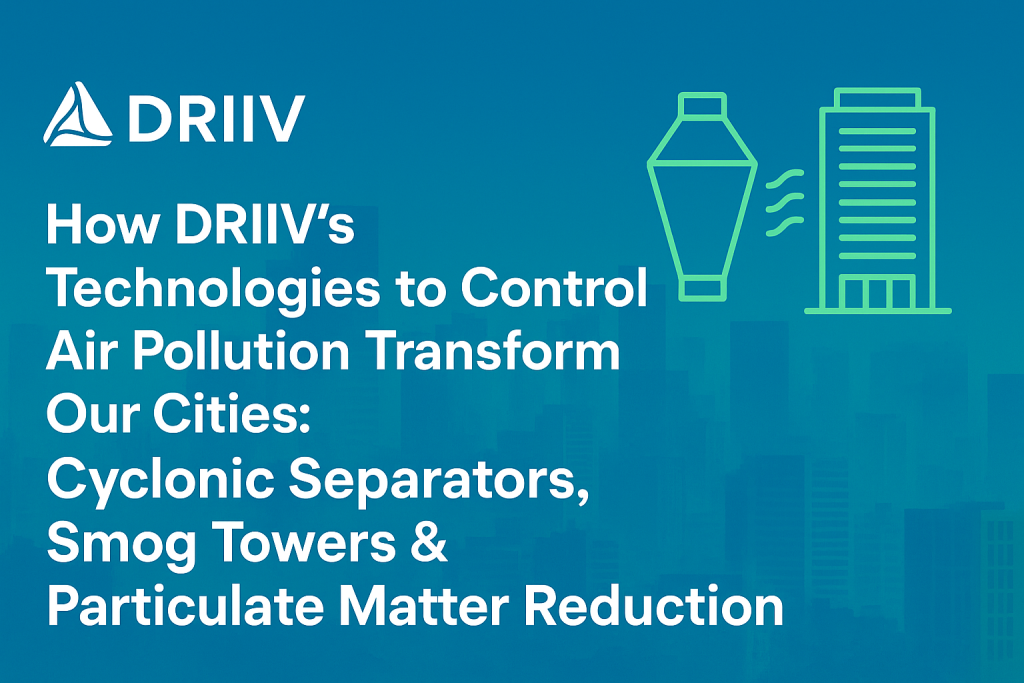Air pollution is one of the biggest environmental challenges of our time. With rising industrial activities, vehicular emissions, construction dust, and burning of fossil fuels, the quality of the air we breathe has deteriorated drastically. In urban areas like Delhi NCR, poor air quality is now a major public health issue.
At DRIIV (Delhi Research Implementation and Innovation), we focus on science-led solutions to ensure cleaner air and a better future for all. This blog explores various mitigation strategies for control of air pollution using the latest technologies to control air pollution, while ensuring long-term environmental sustainability.
Why Is Air Pollution Control Important?
Air pollution leads to respiratory diseases, cardiovascular problems, and even premature deaths. Polluted air affects the environment too—it harms wildlife, damages crops, and accelerates climate change. Therefore, Air pollution mitigation is essential for:
- Protecting public health
- Improving overall air quality
- Reducing greenhouse gas emissions
- Supporting environmental goals
- Achieving sustainable development
Sources of Air Pollution in India
To implement effective mitigation of air pollution, we must understand its main sources:
- Vehicular Emissions – Smoke from cars, trucks, and two-wheelers.
- Industrial Discharge – Emissions from factories and thermal power plants.
- Construction Dust – Airborne dust particles from construction and demolition.
- Waste Burning – Burning of solid waste and crop residue.
- Indoor Pollution – Smoke from cooking, incense sticks, or biomass burning.
Each source needs a specific strategy for the control of air pollution.
Key Mitigation Strategies for Control of Air Pollution
Let’s look at major air pollution mitigation strategies and technologies used globally and in India:
1. Transition to Clean Energy
Using clean energy sources like solar, wind, and green hydrogen can significantly reduce air pollution. Replacing coal-based power plants with renewables is a major step toward environmental sustainability.
Key actions:
- Promote rooftop solar panels
- Invest in wind and hydroelectric power
- Encourage electric vehicles (EVs)
- Shift industries to clean fuels
2. Smog Towers: High-Tech Pollution Fighters
Smog Towers are large air purifiers installed in polluted cities to clean outdoor air. These structures filter air using a combination of technologies like activated carbon, HEPA filters, and ionization.
Benefits of Smog Towers:
- Capture pollutants from the surrounding air
- Provide cleaner air in high-traffic areas
- Effective in urban environments
- Aid in Particulate Matter Reduction
DRIIV has piloted and supported the development of Smog Towers in Delhi NCR to reduce PM2.5 and PM10 levels.
3. Cyclonic Separators: Industrial Dust Control
Cyclonic Separators are devices used in industries to remove large particles like dust and debris from gas emissions. They use centrifugal force to spin polluted air and separate heavier particles.
Advantages of Cyclonic Separators:
- No filters required
- Low maintenance
- Can operate at high temperatures
- Efficient Particulate Matter Reduction
These are widely used in cement plants, steel factories, and other polluting industries to support the control of air pollution.
4. Retrofitting and Upgrading Vehicles
Older vehicles emit more harmful gases. Replacing them with cleaner models or retrofitting them with pollution-control devices reduces emissions significantly.
Technologies used:
- Diesel Particulate Filters (DPFs)
- Selective Catalytic Reduction (SCR)
- Compressed Natural Gas (CNG) kits
- Electric Vehicle (EV) adoption
5. Greening and Urban Forestry
Planting trees and creating green belts help trap airborne particles and improve oxygen levels. Urban forestry can act as a natural air filter and contribute to environmental sustainability.
Green strategies include:
- Green walls and vertical gardens
- Tree plantations along highways
- Rooftop gardens in urban spaces
- Creating green school campuses
6. Smart Monitoring and AI-Based Forecasting
Using data-driven technologies can help predict pollution spikes and allow timely action. DRIIV supports innovations like AI-powered forecasting models to monitor and forecast air pollution.
Tech-based solutions:
- Low-cost air sensors
- Satellite data for pollution mapping
- Real-time AQI dashboards
- Predictive modeling using AI/ML
7. Dust Suppression at Construction Sites
Construction dust is a major contributor to PM pollution. Using dust suppression techniques can reduce airborne particles and support the mitigation of air pollution.
Methods include:
- Anti-smog guns
- Water sprinklers
- Dust curtains
- Covering building materials
8. Waste Management and Bio-Decomposition
Burning solid waste and agricultural stubble increases pollution. DRIIV is working on eco-friendly ways to handle bio-waste using microbial decomposers, thus avoiding open burning.
Sustainable techniques:
- In-situ stubble decomposition
- Community composting
- Waste-to-energy technologies
- Segregation and recycling programs
9. Public Awareness and Citizen Action
Community participation is crucial for effective Air pollution mitigation. Behavioral changes, awareness campaigns, and individual responsibility can drive long-term change.
Examples:
- Carpooling and using public transport
- Avoiding firecrackers
- Supporting green products
- Reporting illegal burning or dumping
Technologies to Control Air Pollution
Let’s list some leading technologies to control air pollution:
| Technology | Function |
| Smog Towers | Outdoor air filtration |
| Cyclonic Separators | Industrial dust removal |
| HEPA Filters | Fine particulate trapping in HVAC systems |
| Biofilters | Remove odors and gases using microbes |
| Electrostatic Precipitators | Remove fine particles from exhaust gases |
| Scrubbers | Remove sulfur dioxide and other gas pollutants |
These solutions are critical for Particulate Matter Reduction and for achieving environmental sustainability.
DRIIV’s Role in Air Pollution Mitigation
DRIIV is a Science and Technology Cluster supported by the Government of India to promote innovation-led sustainable solutions. We work with startups, researchers, and policymakers to implement technologies that ensure cleaner air.
Our contributions include:
- Development of Smog Towers in NCR
- Field trials of stubble decomposer technology
- Deployment of low-cost air monitoring networks
- Collaborations for AI-based pollution forecasting
- Enabling sustainable urban planning solutions
Conclusion: A Collective Step Toward Clean Air
Air pollution cannot be solved overnight, but with focused efforts, the situation can improve significantly. By combining modern technologies to control air pollution with policy support and public action, we can build a cleaner, healthier, and more sustainable India.
At DRIIV, we are committed to driving impactful mitigation of air pollution strategies that align with India’s vision for environmental sustainability and Viksit Bharat 2047.
FAQs: Mitigation Strategies for Control of Air Pollution
1. What are the main strategies for air pollution mitigation in India?
Main strategies include promoting clean energy, electric mobility, dust suppression at construction sites, use of Smog Towers, Cyclonic Separators, and AI-based monitoring systems.
2. What is a Smog Tower and how does it help?
A Smog Tower is a tall outdoor air purifier that removes dust and pollutants from ambient air. It uses multi-layer filtration to reduce particulate matter, especially in urban areas.
3. What are Cyclonic Separators used for?
Cyclonic Separators are used in industries to remove larger dust particles from air emissions. They help in controlling pollution at the source.
4. How can technology help in control of air pollution?
Technologies like real-time air monitoring, AI forecasting, electrostatic precipitators, and smog filters help track, reduce, and eliminate harmful pollutants from the air.
5. What role does DRIIV play in Air pollution mitigation?
DRIIV develops and implements tech-based solutions for air pollution control. From Smog Towers to bio-decomposers and AI forecasting, DRIIV drives innovation for cleaner air.
6. Why is particulate matter reduction important?
Particulate matter (PM2.5 and PM10) are tiny harmful particles that enter our lungs and bloodstream. Reducing PM is crucial for health and environmental quality.
7. How can individuals contribute to reducing air pollution?
Use public transport, avoid burning waste, support clean energy, plant trees, and raise awareness. Every action counts.
8. Is air pollution only an urban problem?
No. While cities suffer more, rural areas also face air pollution due to crop burning, household fuels, and industrial emissions.
Explore More From DRIIV
Visit our website to learn more about our projects on clean air, water conservation, green hydrogen, and more innovative solutions supporting environmental sustainability.




